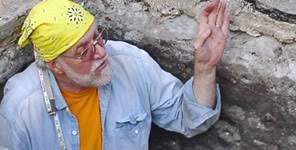Evolution teaching poor in U.S. high schoolsMost U.S. high school biology teachers "fail to forthrightly explain evolutionary biology," finds an educator survey. And at least 13% "strongly support" teaching creationism. Recent advances in the study of human evolution . A poster for a 1985 lecture by Alan Walker.Evolution, the inheritance of changed characteristics across generations, is the fundamental unifying concept underlying biology, as a National Research Council science education standards released in 1996 noted. That report said, "... 'biological evolution' cannot be eliminated from the life science standards." ~USAToday | ||
Looters Smash Treasures And Mummies In Egyptian MuseumLooters broke into the Cairo museum housing the world's greatest collection of Pharaonic treasures, smashing several statues and damaging two mummies, while police battled anti-government protesters on the streets. Arabiya television showed soldiers, armed and in battle fatigues, patrolling the museum that houses tens of thousands of objects in its galleries and storerooms, including most of the King Tutankhamen collection. Display cases were shattered and several broken statues and porcelain figures lay on the floor. ~New York Times | ||
This Week In Pennsylvania ArchaeologyThe production of stone tools dates to 2.6 million years. By the time our ancestors arrived in Pennsylvania, at least 16,000 years ago, they had mastered this technology and were using relatively sophisticated flint knapping techniques. During Paleoindian times (11,150 to 10,000 years ago), these early inhabitants in Pennsylvania quickly discovered the best quality stone for tool manufacture, preferring cherts and jaspers. Paleoindians frequently traveled well over 200 km to obtain the highest quality material in the region.Metarhyolite and quartz were added to the list of preferred lithic materials for chipped stone tools during the Early Archaic period (10,000 to 9000 years ago). By Middle Archaic times (9000 to 6000 years ago), there did not seem to be strong lithic preferences and Native Americans used a variety of materials that were available locally. ~This Week In Pennsylvania Archaeology | ||
Tony Moore makes 'Footsteps of Jesus' seriesYou may have seen Tony Moore on TV, talking about the Holy Land in a series called “In the Footsteps of Paul,” which seeks to bring to life the historical and cultural world of the Bible. Actually, Moore prefers to call it Bible Land. “I don’t consider it holy,” he says, “but it is where the stories happened, so it’s special.”Those who knew Moore when he was a teenager in Salisbury might be surprised to learn how far he’s come since the wild days of his youth. Moore, who now lives in Chino, Calif., was in town recently following the death of his father, Billy Moore, and he found a few hours to talk to the Post about his life’s path.
Newnham College excavationWhen Cambridge University Lecturer in Archaeology Dr Catherine Hills discovered that Anglo Saxon remains could be buried in the grounds of Newnham College, Cambridge, she and her colleagues set about organising a dig to find them. Key to its success would be the help of 20 sixth-form girls from schools in London, Birmingham and Peterborough, all of whom stayed in the college for a week to sample life at Cambridge. What did the girls make of their stay? And did they unearth skeletons in the garden? Expedition Congo2010 - archaeology DR CongoEls Cornelissen at work near Congo River (DRCongo) -Expedition congo2010 - Potterywww.africamuseum.be |
Stanford archaeologist shows how the Romans made pottery in BritainIn the shadow of Hadrian's Wall, Roman soldiers defended their empire's northern borders in Great Britain, passed the time in their bathhouses and inevitably drank a lot of wine. They also made an awful lot of pots.But how? Melissa Chatfield, a research fellow in ceramic geoarchaeology, was determined to find out. Hence, way out on the edge of the Stanford campus, a narrow column of pale smoke rose behind the Stanford Community Farm building last weekend. The source was a 5-foot-high grass mound atop a 12-foot-square wooden box. It was modeled on several ancient kilns in England dating to the first century B.C. and the early Roman kilns that followed. Chatfield and her crew had been creating the mound for six weeks. Climb up on the wet grass and peer down into the hole: About 40 pots glowed in the orange flames in the interior of the kiln, lined with granite cobbles. ~Archaeology Daily | Berlin shows off real-life 'Indiana Jones' treasuresA treasure trove of 3,000-year-old giant birds, lions, and goddesses goes on show in Berlin on Friday with a past so incredible that it could rival archaeology action film hero Indiana Jones.The story kicks off nearly 100 years ago when Max von Oppenheim, the son of a rich German banker, fell in love with the Middle East as a diplomat keeping an eye on British empire-building. He stumbled across the ruined palace of an Aramaean king, buried in the desert, as German engineers toiled on the nearby Berlin to Baghdad railway line along what is today the Turkish-Syrian border. After two digs, from 1911-1913 and 1927-1929, Oppenheim brought back many of his finds to Berlin where they were housed in their own museum. ~Sify News | Open Access Archaeology: Two Different ApproachesArchaeological site information is a precious commodity; once material is fully excavated it is the only knowledge we have of the site. After spending, years (or even decades) excavating a site the information can become packed away in a few notebooks or boxes, lost in the realm of gray material, and not uncovered until needed by another regional specialist or graduate student.Some information becomes a heavily guarded secret to prevent loss of material, either due to looting of the site or forced return due to NAGPRA. A third option now exists: make the information visible on the internet. This is the option that I am advocating for: open access archaeology. ~Cultural Heritage Informatics Initiative |
























